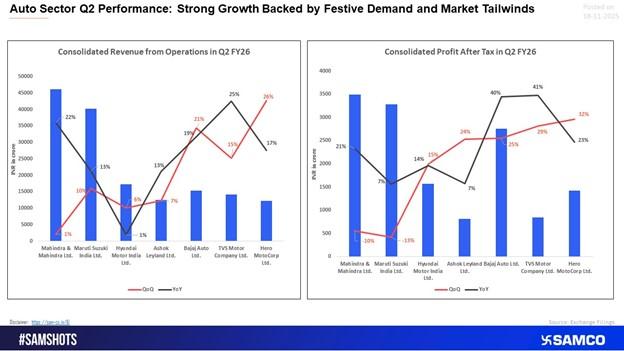The Indian auto sector delivered a resilient Q2 FY26 performance, with most original equipment manufacturers (OEMs) posting solid revenue and profit growth. Despite a challenging quarter for Tata Motors, the broader industry remained strong, supported by festive-season stocking, improving rural sentiment, and a steady export recovery.
This report breaks down the key highlights, revenue trends, profit performance, and forward outlook based on Q2 results.
Q2 FY26 Consolidated Revenue: Broad-Based Growth Across Most OEMs
The majority of leading auto manufacturers recorded strong top-line growth in Q2 FY26:
- Maruti Suzuki: +10% QoQ, +13% YoY
Supported by robust festive stocking and improved demand in rural markets. - Bajaj Auto: +21% QoQ, +19% YoY
Export markets continued to recover, lifting quarterly volumes. - TVS Motor: +15% QoQ, +25% YoY
Consistent domestic demand and new model launches strengthened revenue. - Hero MotoCorp: +26% QoQ, +17% YoY
Benefited from strong festival preparation and recovery in entry-level segment sales. - Eicher Motors: +23% QoQ, +45% YoY
Its premium motorcycle segment continued to outperform the broader market.
The only notable laggard was Tata Motors, which was weighed down by weak performance from its JLR division.
Profitability Remains Strong for Two-Wheeler and Premium OEMs
Profit growth was robust across several manufacturers:
- Bajaj Auto posted a profit of ₹2,756 crore, +25% QoQ, +40% YoY
- TVS Motor reported ₹845 crore, +29% QoQ, +41% YoY
- Hero MotoCorp recorded ₹1,419 crore, +32% QoQ, +23% YoY.
Improved operating leverage, stable commodity prices, and demand-driven volume expansion contributed to margin expansion across the segment.
Tata Motors: The Clear Underperformer Due to JLR Weakness
While most OEMs delivered strong numbers, Tata Motors struggled significantly:
What impacted Tata Motors in Q2?
- Weak JLR Demand in China
Premium segment demand fell amid a broader slowdown in China’s luxury auto market. - Component Shortages
Continued supply chain constraints affected production timelines. - Severe Cyberattack in September
- Halted production for nearly five weeks
- Resulted in a one-time financial charge of $228.5 million
- Halted production for nearly five weeks
- Margin Pressure Across PV and CV Divisions
Both divisions saw weaker profitability due to lower contribution from JLR.
This made Tata Motors the only major OEM to drag sector performance during the quarter.
Key Drivers Supporting Auto Sector Growth in Q2 FY26
1. Festive Season Stocking
Dealerships increased inventory in anticipation of strong festive demand, driving sequential sales growth.
2. Improving Rural Sentiment
Better monsoon conditions and farm income recovery supported entry-level and commuter vehicle sales.
3. Export Recovery
Countries in Africa and Latin America showed gradual demand improvement, benefitting companies like Bajaj Auto and TVS.
4. Stable Input Costs
Cooling commodity prices helped OEMs protect margins while maintaining competitive pricing.
Auto Sector Outlook for H2 FY26: Positive Momentum Expected
Despite Tata Motors’ underperformance, the broader sector outlook remains constructive.
Key tailwinds for the next two quarters:
- GST 2.0 rollout is likely to simplify compliance and improve supply-chain efficiency.
- Moderating inflation could support disposable income and boost retail auto demand.
- Festive and wedding season demand is expected to remain strong.
- Continued export recovery may support growth for two-wheeler exporters.
Overall, the industry is well-positioned to sustain growth momentum heading into H2 FY26, with strong consumer demand and easing supply-side constraints.
Conclusion
The auto sector showcased a strong and broad-based Q2 FY26 performance despite a temporary setback from Tata Motors. Robust revenue and profit growth from leading OEMs such as Maruti Suzuki, Bajaj Auto, TVS Motor, and Hero MotoCorp underscore improving fundamentals and favorable market tailwinds. With GST reforms, stable commodity prices, and continued festive momentum, the sector’s outlook for the coming quarters remains positive.





 Easy & quick
Easy & quick
Leave A Comment?